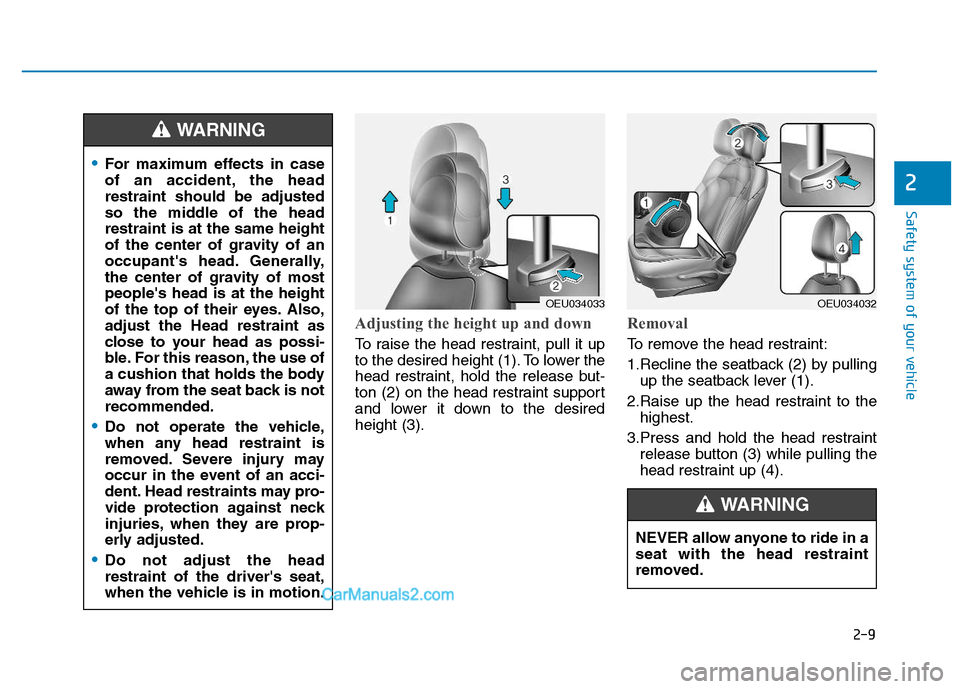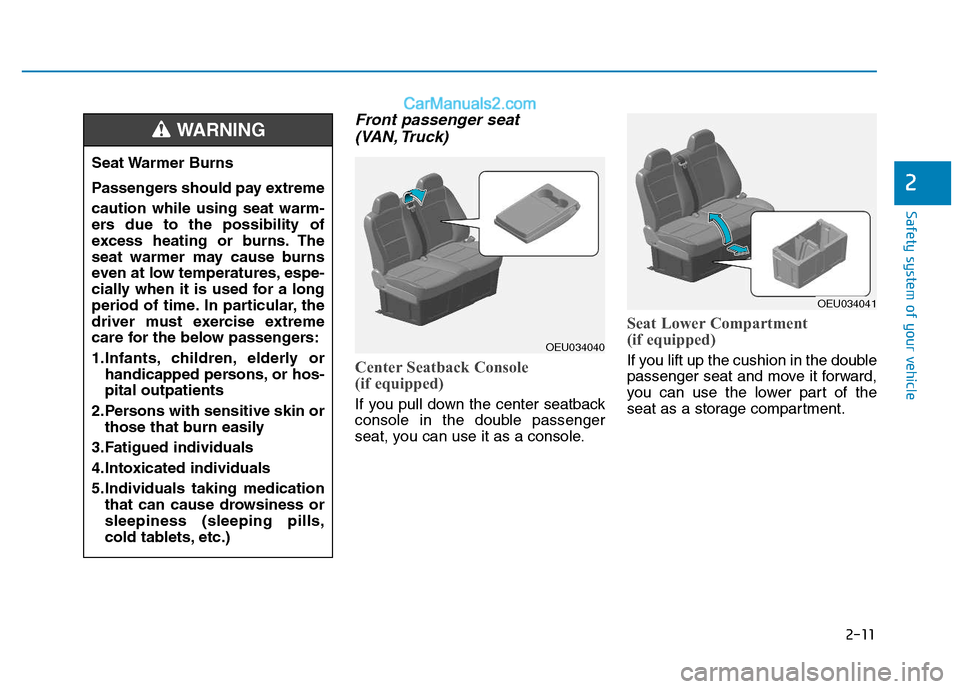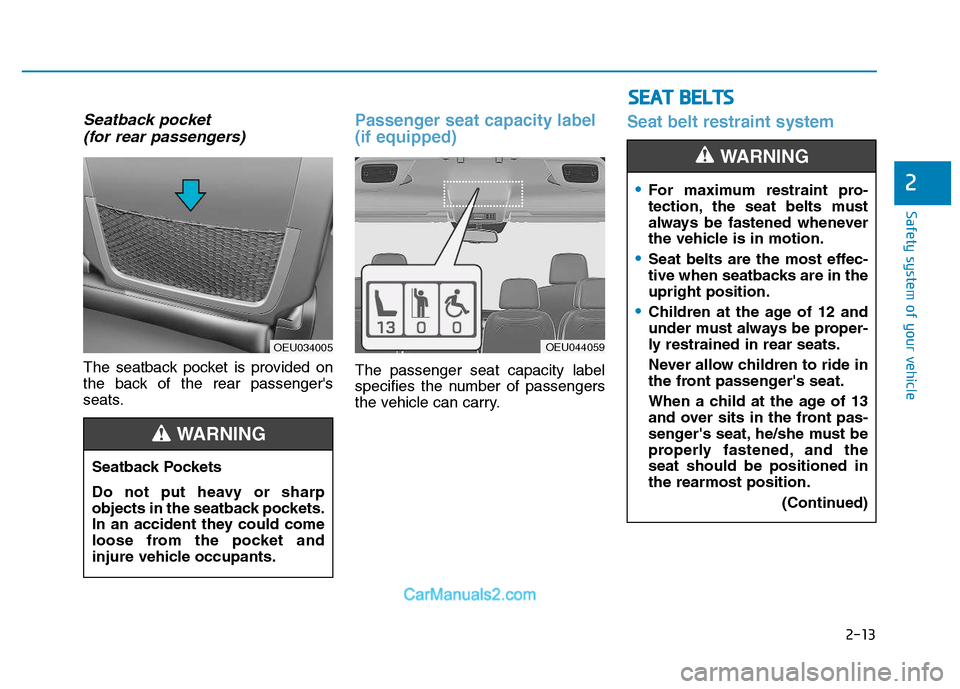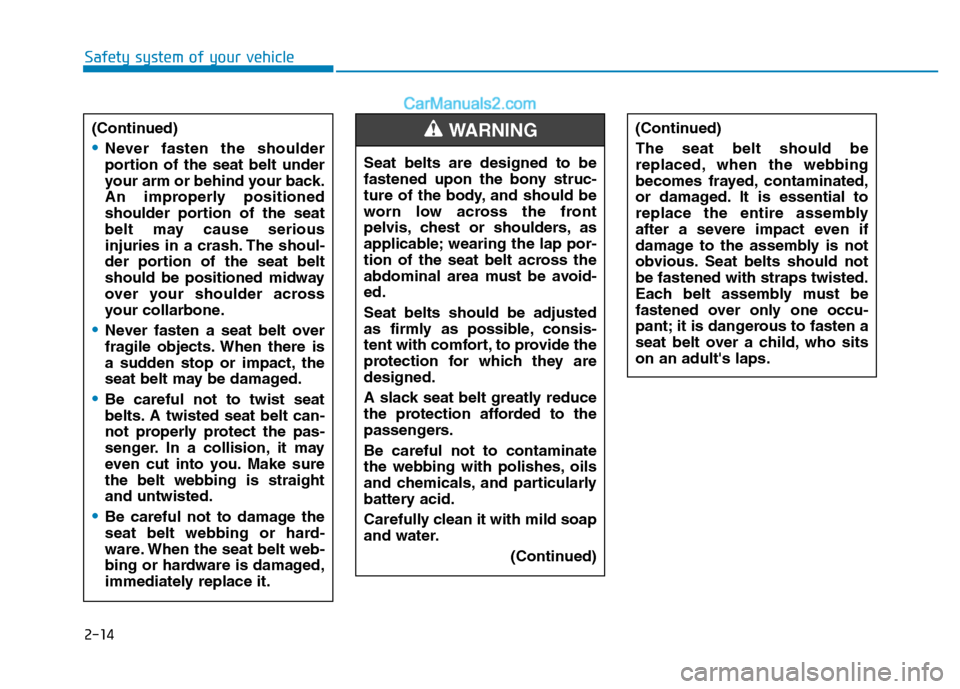Page 29 of 473

2-9
Safety system of your vehicle
2
Adjusting the height up and down
To raise the head restraint, pull it up
to the desired height (1). To lower the
head restraint, hold the release but-
ton (2) on the head restraint support
and lower it down to the desiredheight (3).
Removal
To remove the head restraint:
1.Recline the seatback (2) by pullingup the seatback lever (1).
2.Raise up the head restraint to the highest.
3.Press and hold the head restraint release button (3) while pulling the
head restraint up (4).
For maximum effects in case
of an accident, the headrestraint should be adjusted
so the middle of the headrestraint is at the same height
of the center of gravity of an
occupant's head. Generally,
the center of gravity of mostpeople's head is at the height
of the top of their eyes. Also,adjust the Head restraint as
close to your head as possi-
ble. For this reason, the use of
a cushion that holds the body
away from the seat back is notrecommended.
Do not operate the vehicle,
when any head restraint is
removed. Severe injury may
occur in the event of an acci-
dent. Head restraints may pro-
vide protection against neck
injuries, when they are prop-
erly adjusted.
Do not adjust the head restraint of the driver's seat,
when the vehicle is in motion.
WARNING
OEU034033OEU034032
NEVER allow anyone to ride in a seat with the head restraint
removed.
WARNING
Page 30 of 473

2-10
Safety system of your vehicle
Reinstall
To reinstall the head restraint:
1.Put the head restraint poles (2) intothe holes while pressing the
release button (1).
2.Recline the seatback (4) by pulling up the seatback lever (3).
3.Adjust the head restraint to the desired height.
Seat warmer (if equipped)
The seat warmer is equipped to
warm the front seats during cold
weather.
With the ignition switch in the ON
position, push either of the switches
to warm the driver's seat or the frontpassenger's seat.
In the mild weather or under condi-
tions where the operation of the seat
warmer is unnecessary, keep the
switches in the "OFF" position. Information
Even with the seat warmer switch in
the ON position, the seat warmer
automatically turns ON and OFF
depending on the seat temperature.
Do not use an organic solvent such as thinner, benzene, alco-
hol and gasoline to clean the
seat. Doing so may damage thesurface of the heater or seats.
To prevent the seat warmer from being overheated, do not place
anything on the seats that
blocks the thermal emission,
such as blankets, cushions or
seat covers, when the seatwarmer is in operation.
Do not place heavy or sharp objects on the seats equipped
with seat warmers. Damage tothe seat warming components
may occur.
Do not change the seat cover. It may damage the seat warmer orthe air ventilation system.
NOTICE
i
OEU034031
Always make sure the head
restraint is locked into positionafter reinstalling or adjusting it.
WARNING
OEU034025
Page 31 of 473

2-11
Safety system of your vehicle
Front passenger seat (VAN, Truck)
Center Seatback Console
(if equipped)
If you pull down the center seatback
console in the double passenger
seat, you can use it as a console.
Seat Lower Compartment
(if equipped)
If you lift up the cushion in the double
passenger seat and move it forward,
you can use the lower part of the
seat as a storage compartment.
2
Seat Warmer Burns
Passengers should pay extreme caution while using seat warm-
ers due to the possibility of
excess heating or burns. The
seat warmer may cause burns
even at low temperatures, espe-
cially when it is used for a long
period of time. In particular, the
driver must exercise extreme
care for the below passengers:
1.Infants, children, elderly or handicapped persons, or hos- pital outpatients
2.Persons with sensitive skin or those that burn easily
3.Fatigued individuals
4.Intoxicated individuals
5.Individuals taking medication that can cause drowsiness or sleepiness (sleeping pills,
cold tablets, etc.)
WARNING
OEU034040
OEU034041
Page 32 of 473
2-12
Safety system of your vehicle
Rear seats
Adjusting seatback angle
To recline the seatback, lean forward
to take your weight off, and then pull
up the seatback lever on the side of
the seat. Now lean back to adjust the
seatback to the desired angle. To
lock the seatback in position, release
the seatback lever.
Adjusting the armrest angle (if equipped)
The armrest will be raised or lowered
manually.
To raise the armrest, pull it up.
To lower it, press the armrest down.
OEU034003 NEVER ride in a reclined seat,
when the vehicle is in motion.
Riding in a reclined seat
increases your risk of being
seriously or fatally injured in
the event of a collision or sud-den stop.
Drivers and passengers should
ALWAYS sit well back in their
seats, properly fastened, and in
a properly upright position.
WARNING
OEU034004
Page 33 of 473

2-13
Safety system of your vehicle
2
Seatback pocket (for rear passengers)
The seatback pocket is provided on
the back of the rear passenger's
seats.
Passenger seat capacity label (if equipped)
The passenger seat capacity label
specifies the number of passengers
the vehicle can carry.
Seat belt restraint system
OEU034005
Seatback Pockets
Do not put heavy or sharp
objects in the seatback pockets.
In an accident they could come
loose from the pocket and
injure vehicle occupants.
WARNING
OEU044059
SS EE AA TT BB EELLTT SS
For maximum restraint pro-
tection, the seat belts must
always be fastened whenever
the vehicle is in motion.
Seat belts are the most effec-
tive when seatbacks are in theupright position.
Children at the age of 12 and
under must always be proper-
ly restrained in rear seats.
Never allow children to ride in
the front passenger's seat.
When a child at the age of 13
and over sits in the front pas-
senger's seat, he/she must be
properly fastened, and theseat should be positioned inthe rearmost position. (Continued)
WARNING
Page 34 of 473

2-14
Safety system of your vehicle
(Continued)
Never fasten the shoulder
portion of the seat belt under
your arm or behind your back.
An improperly positioned
shoulder portion of the seat
belt may cause serious
injuries in a crash. The shoul-
der portion of the seat belt
should be positioned midway
over your shoulder across
your collarbone.
Never fasten a seat belt over
fragile objects. When there is
a sudden stop or impact, the
seat belt may be damaged.
Be careful not to twist seat
belts. A twisted seat belt can-
not properly protect the pas-
senger. In a collision, it may
even cut into you. Make surethe belt webbing is straightand untwisted.
Be careful not to damage the
seat belt webbing or hard-
ware. When the seat belt web-
bing or hardware is damaged,
immediately replace it.
Seat belts are designed to be
fastened upon the bony struc-
ture of the body, and should be
worn low across the front
pelvis, chest or shoulders, as
applicable; wearing the lap por-
tion of the seat belt across the
abdominal area must be avoid-ed. Seat belts should be adjusted
as firmly as possible, consis-
tent with comfort, to provide the
protection for which they aredesigned.
A slack seat belt greatly reduce
the protection afforded to the
passengers. Be careful not to contaminate
the webbing with polishes, oils
and chemicals, and particularly
battery acid.
Carefully clean it with mild soap
and water.(Continued)
WARNING (Continued) The seat belt should be
replaced, when the webbing
becomes frayed, contaminated,
or damaged. It is essential to
replace the entire assembly
after a severe impact even if
damage to the assembly is not
obvious. Seat belts should notbe fastened with straps twisted.
Each belt assembly must be
fastened over only one occu-
pant; it is dangerous to fasten a
seat belt over a child, who sitson an adult's laps.
Page 35 of 473

2-15
Safety system of your vehicle
2
Seat belt warning
As a reminder to the driver, the seat
belt warning light is turned ON for
approximately 6 seconds each time
you turn the ignition switch ON
regardless of belt fastening.
When the vehicle start to move with-
out fastening the seat belt with the
ignition switch ON, the seat belt
warning light flashes until it stops.
When the vehicle drives faster than
20km/h without fastening the seat
belt with the ignition switch is ON, the
seat belt warning chime will sound
for approximately 100 seconds.
No modifications or additions
should be made by the user,
as it may fail the seat belt
adjusting devices, or fail the
seat belt assembly from being
adjusted to remove slack to
be tightly fastened without
any slack.
When you fasten the seat belt,
be careful not to latch the seat
belt tap in the buckles of otherseats.
It is very dangerous, and you
may not be properly protected
by the seat belt.
Do not fasten or unfasten the seat belt in a repetitive man-
ner, while driving. This may
result in loss of control, and
an accident, causing death,
serious injury, or property
damage.(Continued)
WARNING (Continued)
While fastening the seat belt, make sure that the seat belt is
not fastened over a hard or a
fragile object.
Make sure that there is noth-
ing in the buckle. If so, the
seat belt may not be securelyfastened.
1GQA2083
Page 37 of 473

2-17
Safety system of your vehicle
2
Height adjustment
You can adjust the height of the seat
belt anchor to one of 4 positions for
your comfort and safety. When the height of the seat belt anchor is too close to the occupant's
neck, the most effective protection is
not guaranteed.
The shoulder portion should befas-
tened across your chest and midway
over your shoulder nearest the door,
not over your neck.
To adjust the height of the seat belt
anchor, pull it up or pull it down to an
appropriate height.To raise up the seat belt anchor, pull
it up (1). To lower it down, pull it down
(3) while pressing the release button (2).
Release the button to lock the
anchor in position. Attempt to slide
up and down the anchor to make
sure that it is securely locked in posi-tion.
OHD036019
■
Front seat
Make the shoulder belt sure
that the anchor is locked in
position at the appropriate
height. Never fasten the
shoulder portion across your
neck or face. Improperly posi-
tioned seat belts may cause
serious injury in an accident.
Failure to replace seat belts
after an accident may leave
you with damaged seat belts
that will not provide protec-
tion in the event of another
collision, resulting in personal
injury or death. Immediately
replace your seat belts afteran accident.
WARNING B200A01NF
You should fasten the lap belt
as low as possible and snugly
across your hips, not across
your waist. When the lap belt is
located too high across your
waist, it may increase the
chance of injury in the event of
a collision. Both arms should
not be under or over the seat
belt. Rather, one should be over
and the other under, as shown
in the illustration. Never fastenthe seat belt under the arm
nearest the door.
WARNING